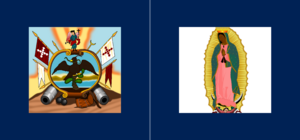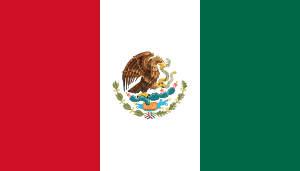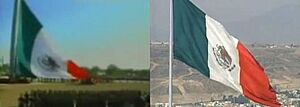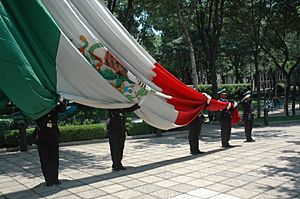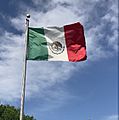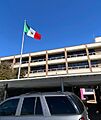Flag of Mexico facts for kids
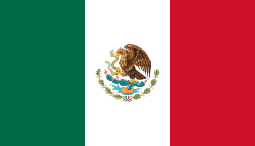 |
|
| Use | National flag and ensign |
|---|---|
| Proportion | 4:7 |
| Adopted | 16 September 1968 |
| Design | A vertical tricolor of green, white and red, with the National Coat of Arms centered on the white band. |
| Designed by | Agustin de Iturbide (Original version) Francisco Eppens Helguera |

Variant flag of Mexico
|
|
| Use | Naval jack |
| Proportion | 1:1 |
| Design | A diagonal tricolor of white, green, red, with a thin anchor in the center. Three eight-pointed gold stars are in the canton, and the bottom two corners. |
The national flag of Mexico is a colorful symbol of the country. It has three vertical stripes: green, white, and red. In the middle of the white stripe, you'll see the Mexican coat of arms.
The colors of the flag have special meanings. Green stands for hope and independence. White represents unity and purity. Red symbolizes the blood shed by national heroes. These colors were chosen after Mexico gained its independence from Spain.
The central design on the flag is the Mexican coat of arms. It shows a golden eagle perched on a cactus, eating a serpent. This image comes from an ancient Aztec legend. The legend says that the Aztecs were told to build their city, Tenochtitlan (now Mexico City), where they saw an eagle on a cactus eating a snake. This symbol reminds Mexicans of their rich history and the founding of their capital.
Contents
The Story of the Mexican Flag
The Mexican flag has changed a few times throughout history. Before the first official flag, different banners were used during the War of Independence.
One important early flag was the Standard of the Virgin of Guadalupe. Miguel Hidalgo carried this flag when the fight for independence began in 1810. It became a key symbol for the rebel army. Other leaders, like José María Morelos, also used flags with images of the Virgin Mary.
The First National Flags
The first national flag was created in 1821, after Mexico became an independent country. It had the same green, white, and red stripes. The eagle on this flag had a crown, showing that Mexico was an empire at the time. This flag was used until the empire ended.

In 1823, Mexico became a republic. A new flag was adopted, which looked very similar to today's flag. The main change was that the crown was removed from the eagle's head. Also, a serpent was added to the eagle's right talon, and branches of oak and laurel were included. These branches are still on the flag today.
The Flag of the Second Empire
From 1864 to 1867, during the Second Mexican Empire, the flag changed again. It still had the green, white, and red stripes. However, the flag's shape was different, and there were four eagles with crowns in each corner. This design was ordered by Emperor Maximilian.
The Modern Mexican Flag
The flag we see today was officially adopted on September 16, 1968. Its design was confirmed by law in 1984. Before this, the eagle on the coat of arms faced forward. In 1916, it was changed to face sideways.
One reason for the 1968 flag change was that Mexico City was hosting the Olympic Games. The government also wanted to make sure Mexico's flag was clearly different from the Italian flag, which has similar colors but no coat of arms.
In 1984, a rule was added about how the coat of arms should look on the back of the flag. When you see the flag from the reverse side, the eagle should appear to be standing on its right talon, holding the serpent with its left talon and beak.
Flag Design and Colors
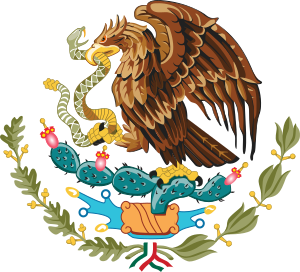
The official design of the Mexican flag is described in Article 3 of the Law on the National Arms, Flag, and Anthem. This law was passed in 1984. While the exact shades of the colors aren't strictly defined by law, here are the suggested colors:
| Colour scheme | Green | White | Red | |||
|---|---|---|---|---|---|---|
| Pantone | 3425c | Safe | 186c | |||
| RGB | 0-104-71 | 255-255-255 | 206-17-37 | |||
| CMYK | 100-34-93-30 | 0-0-0-0 | 0-92-82-19 | |||
| Web colors | 006847 | FFFFFF | CE1125 | |||
The law also states that the flag is a rectangle. It is divided into three vertical stripes of equal size. The green stripe is on the left, white in the middle, and red on the right. The coat of arms in the center is three-fourths the width of the white stripe. The flag's overall proportion is 4:7, meaning it's longer than it is tall.
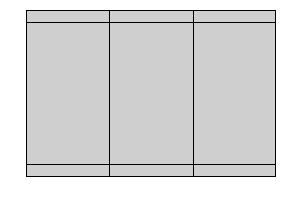
The Mexican flag has been used longer than the Italian flag, which looks similar. Both flags use green, white, and red. However, the Mexican flag has darker shades of green and red. Also, the Mexican flag is longer (4:7 ratio) than the Italian flag (2:3 ratio). The coat of arms on the Mexican flag also helps tell them apart.
Flag Etiquette and Traditions
Mexicans show great respect for their flag. When the flag is displayed, people in military uniform salute it. Civilians also have a special salute: they stand at attention, raise their right arm, and place their right hand flat on their chest, over their heart. This is called the El saludo civil a la Bandera Nacional (The Civil Salute to the National Flag).

The flag is flown on many national holidays and important dates. Sometimes, it is flown at half-mast to honor important Mexicans who have passed away. These dates are listed in Article 18 of the Law of the National Flag, Arms, and Anthem.
Flag Day
Día de la Bandera (Flag Day) is celebrated every year on February 24. On this day in 1821, different groups fighting for independence came together. They formed the Army of the Three Guarantees and declared Mexico an independent country. General Vicente Guerrero was the first military leader to promise loyalty to the national flag.
Another tradition is that before every Olympic Games, the President gives a flag to the chosen flag bearer. This person then carries the flag to the host city.
Flag Songs and Pledges
There are special songs and pledges dedicated to the flag. These are often used during Flag Day celebrations.
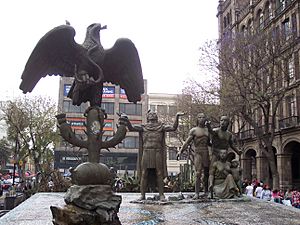
Here is "The Oath to the Flag," often recited during ceremonies:
|
|
And here is "The Salute to the Flag":
|
|
A special "Pledge of Fidelity" is also taken on February 22. It is also used when new flags are given to schools or military groups.
|
|
Flag Variants
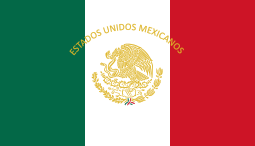 |
|
| Name | Presidential Standard of Mexico |
|---|---|
| Use | State flag |
| Proportion | 4:7 |
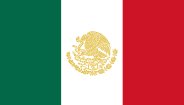
Variant flag of Mexico (variants)
|
|
| Name | Variant of the Presidential Standard |
| Use | State flag |

Variant flag of Mexico (variants)
|
|
| Name | Cravat |
There are two main variations of the national flag. These are mostly used by the state and federal governments. The difference is in the design of the coat of arms.
In the first variant, used by the President of Mexico and federal departments, the entire coat of arms is gold. The only exceptions are the green, white, and red ribbon, and the stone, lake, and eagle's talons, which are silver.
The second variant has the entire coat of arms colored gold, including the ribbon, lake, stone, and talons. This version is mostly used by state governments and other federal groups.
Flag Decorations
The national flag can also be decorated with a special tie called a corbata (cravat). The corbata has a bow and two ribbons of different lengths. Both ribbons are attached with a golden tassel called a fringe. The corbata is placed at the top of the flag, and its colors match the national flag.
Organizations and political parties can also have their own corbatas. For example, the National Action Party (PAN) uses a white corbata with blue fringes.
The image of the flag is protected by law. A special permit is needed to broadcast its image.
Monumental Flags
In 1999, President Ernesto Zedillo started a program to put up giant flags across Mexico. These huge flags, called banderas monumentales (monumental flags), were placed in important cities.
The first monumental flags were in Mexico City, Tijuana, Ciudad Juárez, and Veracruz. These flags measure about 14.3 by 25 meters (47 by 82 feet). They are raised on flagpoles that are 50 meters (164 feet) high. Later, other cities like Ensenada and Cancún also got their own monumental flags.
Smaller flags, called banderas semi-monumentales, are put up in smaller towns and at schools.
The largest Mexican flag in the world is located in Piedras Negras, Coahuila. Its flagpole is 120 meters (394 feet) tall, making it one of the tallest in the world. The flag itself measures 60 by 34 meters (197 by 112 feet) and weighs 420 kilograms (926 pounds)!
Mexico's first largest monumental flag was in Monterrey. Its flagpole was 100.6 meters (330 feet) high. The flag measured 50 by 28.6 meters (164 by 94 feet) and weighed 230 kilograms (507 pounds).
Images for kids
-
Flag waving over the Consulate-General of Mexico in Houston.
See also
 In Spanish: Bandera de México para niños
In Spanish: Bandera de México para niños
- List of Mexican flags
- State flags of Mexico
- Flag flying days in Mexico
- Himno Nacional Mexicano
- Coat of arms of Mexico


